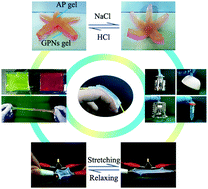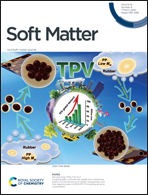A self-healing, robust adhesion, multiple stimuli-response hydrogel for flexible sensors†
Abstract
Ionic hydrogels have great application potential in human index monitoring and wound treatment, such as in wearable sensors, wound dressings, and ionic skin. However, the design of a hydrogel achieving the synergistic characteristics of excellent mechanical properties, robust adhesion, and multiple stimuli-responses remains a critical challenge. Herein, by introducing negatively charged clay nanosheets, we report a smart ionic Gelatin/PAAm/Clay hydrogel (GPNs gel) with a high conductivity of 10.87 mS cm−1. The as-prepared gel exhibits excellent self-healing properties, robust adhesion (interfacial toughness of up to 485 J m−2 with pigskin), and multiple stimuli-responses driven by salt ions, pH, and stress. Based on this hydrogel, a capacitive sensor has also been designed, which provides linear responses over a wide range (applied pressure up to 2 kPa) and sensitively monitors human motion. In addition, the gel also displays good biocompatibility with human lung embryonic (MRC-5) cells. These characteristics demonstrate that the GPNs gel is an ideal candidate for developing flexible sensor devices.



 Please wait while we load your content...
Please wait while we load your content...